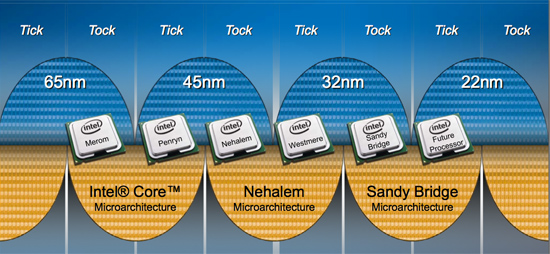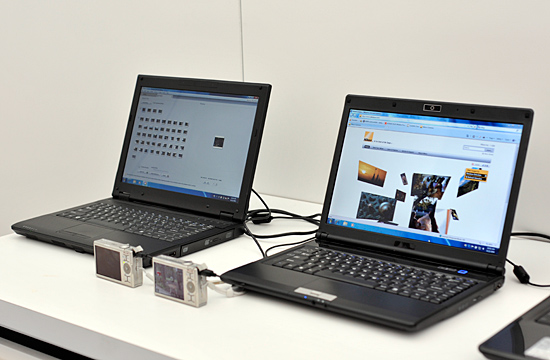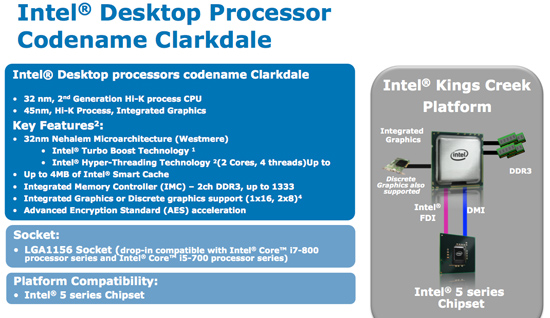The Real Conroe Successor: Clarkdale & All You Need to Know about Westmere
by Anand Lal Shimpi on September 24, 2009 6:00 PM EST- Posted in
- CPUs
Intel spent a lot of time talking about Nehalem a year ago, but not much time on Westmere. It's the tick to Nehalem's tock, or in other words, it's 32nm Nehalem.

Unlike previous die shrinks, we don't get larger caches with Westmere - Nehalem was already too big to begin with. Westmere keeps the same architecture, same cache sizes (or ratios) as Nehalem. It's all built using smaller 32nm transistors and on a smaller die. For the same core count, expect Westmere to be roughly half the size.
But the same core counts aren't what you're going to get. I included the table below in yesterday's Core i7 920XM preview:
| Codename | Market | Cores | Manufacturing Process |
| Bloomfield | Desktop | 4 | 45nm |
| Lynnfield | Desktop | 4 | 45nm |
| Clarkdale | Desktop | 2 | 32nm |
| Clarksfield | Mobile | 4 | 45nm |
| Arrandale | Mobile | 2 | 32nm |
The Westmere products are Gulftown, Clarkdale and Arrandale. That's six, two and two cores. Lynnfield is the last quad-core on the roadmap for the foreseeable future.

We'll talk about Gulftown later, but the focus today is Clarkdale with a little Arrandale.
Meet the 'dales
Arrandale and Clarkdale are the first two Westmere family members you'll meet. Both are technically due out later this year, although we won't see large volumes (by Intel standards) until Q1 2010. Both Arrandale and Clarkdale are dual-core Westmere parts with on-package graphics. The only difference is that Arrandale is mobile while Clarkdale is desktop.

Arrandale running - Hyper Threading helps improve performance even in normal workloads

The desktop socket is LGA-1156, the same socket as Lynnfield. The mobile socket is mPGA-989, the same socket as Clarksfield.










96 Comments
View All Comments
Wolfpup - Friday, October 16, 2009 - link
Dual core CPUs in 2010, AFTER we've had quad core for three generations, and even have a fairly reasonably priced Core i7 in NOTEBOOKS now? Boooooring!cosminliteanu - Wednesday, September 30, 2009 - link
Hi,anybody know when Intel will add support for USB 3 and SATA 6 GB? And most important in which chipset/platform will be ?
Thanks.
NeBlackCat - Tuesday, September 29, 2009 - link
Once again AMD will be getting my money as I'm not being forced to buy two motherboards to get the CPU that I want now (Clarkdale) and it's immediate successor.
I'm sure you're gutted.
SFNR1 - Tuesday, September 29, 2009 - link
what PSU was being used?IKeelU - Monday, September 28, 2009 - link
I hope that mini-ITX is < 100$. I'll finally be able to upgrade from my existing atom board and its measly 2 SATA ports.cjs150 - Tuesday, September 29, 2009 - link
Exactly. Personally I am excited by this. I need to build a couple of things for the home network1. HTPC - this needs to be very very quiet. This new CPU and Mini ITX board looks spot on if (and it is a big if) Intel actually delivers on HD acceleration for both video and audio
2. Small home server to replace the ancient thing currently flogging its guts out. This looks close - low power is good but I have two big requirements. (a) standard PCI slot for my RAID card which is an 8 port SATA raid card (Broadcomm) which just works exactly as it should. (b) with all the HD streams 2 xGb ethernet ports would be nice to allow for future expansion (and yes I know it is overkill). Looks like the current minim-itx board fails on both
CrimsonFury - Thursday, October 8, 2009 - link
An 8 port SATA controller is very limited via standard PCI.Even a PCI-E x1 slot would double the bandwidth (x4 or or x8 would be better)
Just use one of the mini-ITX boards that has a PCI-E x16 slot and check a PCI-E sata controller in there.
Holy Smoke - Saturday, September 26, 2009 - link
Am I the only one who finds the tock-tick thingy retarded?It's the wrong sequence, dammit! It's like an army going 3-4-1-2 fer chrissakes!
2good2btrue - Monday, September 28, 2009 - link
Okay, how is this the wrong sequence?They optimize the circuit design, from a known good/working design, then they optimize it at the smallest current size possible.
How is this retarded?
strikeback03 - Monday, September 28, 2009 - link
I'd guess he is arguing that the tick should be the new microarchitecture, and the tock should be the shrink of that.